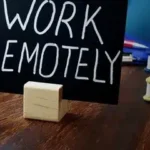Making the switch from an on-site job to remote work can feel like stepping into a whole new world. You imagine the freedom of working in pajamas, setting your schedule, and escaping office politics. But then reality hits: deadlines don’t disappear, distractions lurk in every corner of your home, and if you’re not careful, your productivity can tank before you even realise it.
I’ve always leaned towards remote work. Even when I worked on-site, I craved the flexibility that came with working from home. I never missed office chatter or watercooler gossip, and the idea of commuting daily felt like a nightmare. But making the transition wasn’t without its challenges. Many people romanticize remote work, assuming it’s all about freedom and comfort. And while those aspects exist, there are plenty of mistakes that can turn the dream into a frustrating reality.
If you’re about to make the shift, or if you’ve already dipped your toes in but feel like you’re struggling, let me save you some headaches by sharing what I’ve learnt the hard way.
Thinking You’ll Automatically Be More Productive
This is one of the biggest traps people fall into. They assume that because they’re working from home, without office distractions, their productivity will soar. No more coworkers dropping by your desk. No more unnecessary meetings. Just you and your work. Right? Ah Ah
But then, the distractions at home start creeping in. You remember that load of laundry you meant to do. Your phone is right there, and one quick check turns into a 30-minute scroll on Instagram. Before you know it, the workday is over, and your to-do list is still full. 🤦♀️
Remote work demands discipline. I had to learn how to set clear boundaries with myself. Just because I was home didn’t mean I could mix personal tasks with work whenever I pleased. Establishing a structured routine, waking up at the same time, designating work hours, and setting clear goals for the day—made all the difference.

Underestimating the Importance of a Dedicated Workspace
When I first started working remotely, I thought I could work from anywhere. My bed, the couch, the dining table—I tried them all. And while that freedom felt great at first, it quickly became a problem. I found myself struggling to concentrate. My brain associated the couch with relaxation, so I’d end up watching YouTube instead of working. Working from bed? That was even worse. I started associating my sleep space with work, and suddenly, I was neither sleeping well nor working effectively.
Having a dedicated workspace matters more than you think. Even if you don’t have a home office, setting up a corner of your room with a desk and comfortable chair can significantly improve focus and productivity. It signals to your brain that when you sit there, it’s time to work, not scroll through social media or take an unplanned nap.
Failing to Set Clear Work-Life Boundaries
One of the biggest myths about remote work is that it gives you more work-life balance. And while that’s possible, it doesn’t just happen automatically. Without a physical office to leave, work can start bleeding into personal time. Before you know it, you’re answering emails at 10 PM and working on weekends.
I made this mistake early on. Since I no longer had a commute, I felt like I should start work earlier and keep going later. The result? Burnout. I had to learn to set boundaries, both for myself and for others. Just because I worked from home didn’t mean I was available 24/7. Establishing a clear start and end time for work and actually logging off when the day was over helped me regain balance.
Assuming Isolation Will Be a Problem (or Not Realizing That It Might Be for You)
Personally, I’ve never had an issue with isolation. I love working in my own space, free from distractions. Office chatter and forced small talk were never my thing, so being alone during work hours was a relief, not a problem. But I know not everyone feels the same way. Some people thrive on social interactions and struggle with the solitude that comes with remote work.
If you’re someone who enjoys a lively work environment, the transition can be tough. Loneliness is a real challenge for many remote workers. The good news? There are ways to combat it. Scheduling virtual coworking sessions, making time for in-person social interactions after work, or even working from a café once in a while can help.
But if you’re like me and isolation doesn’t bother you, don’t let anyone convince you that you “should” feel lonely. Some of us function better in quiet, independent settings. The key is knowing yourself and setting up your work environment in a way that suits you best.
Not Communicating Enough with Your Team
One of the biggest mistakes remote workers make—especially those coming from an office setting—is assuming that communication will happen naturally. When you’re in an office, you can casually update your manager or colleagues just by walking over to their desks. But in a remote job, no one sees what you’re doing unless you tell them.
Early on, I realized that overcommunication is better than under-communication. Whether it’s providing regular updates on projects, checking in with colleagues, or asking for clarity when needed, proactive communication helps avoid misunderstandings and keeps things running smoothly. Remote work requires intentional effort to stay connected, and assuming people “just know” what you’re working on is a recipe for confusion.
Ignoring Your Health and Well-Being
When you work remotely, it’s easy to fall into unhealthy habits. You’re no longer walking to and from the office, and the temptation to snack constantly is real. I had to make a conscious effort to incorporate movement into my day. Taking short walks, stretching between tasks, and making time for exercise helped me avoid the physical toll of sitting for hours on end.
Beyond physical health, mental well-being is just as crucial. Burnout can creep up on you if you’re not careful. Taking breaks, setting realistic workloads, and making time for hobbies outside of work have been essential for maintaining a healthy work-life balance.
Relying Too Much on Flexibility
One of the biggest perks of remote work is flexibility, but too much of it can backfire. When I first started, I loved the idea of working whenever I wanted. But without structure, my productivity took a hit. Having the freedom to set your own schedule is great, but D.I.S.C.I.P.L.I.N.E is what makes it work. I can’t say this enough.
I found that keeping a consistent routine helped me stay on track. Whether you’re working set hours or have flexible deadlines, having a daily plan ensures that work actually gets done instead of piling up.
Transitioning to a remote job is a game-changer, but it comes with its own set of challenges. Thinking you’ll automatically be more productive, failing to set up a dedicated workspace, allowing work-life boundaries to blur, struggling with communication, neglecting your health, and over-relying on flexibility are just some of the pitfalls that can make remote work harder than it needs to be.
But with the right mindset and habits, remote work can be incredibly fulfilling. For me, it has been the best decision. I love the independence, the ability to structure my day, and the freedom it gives me to focus on what truly matters. And if you approach it with intention, you might just find that it’s the perfect fit for you too.
If you’re currently navigating this transition, know that it gets easier with time. And if you’ve already been working remotely for a while, I’d love to hear what mistakes you made early on and what you learnt from them. Share in the comments.
Stay frosty!




